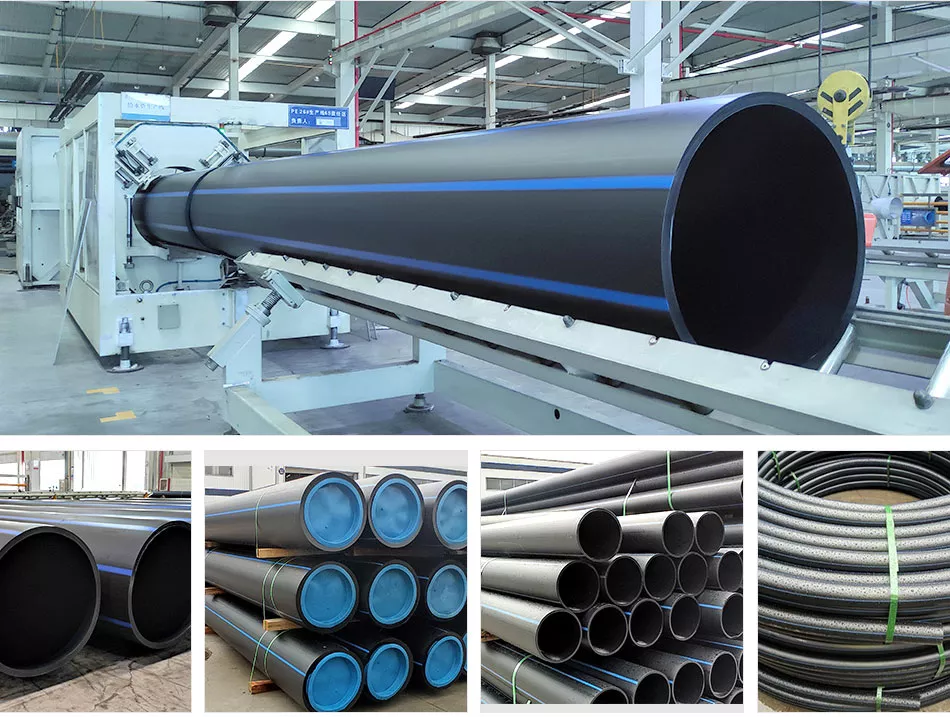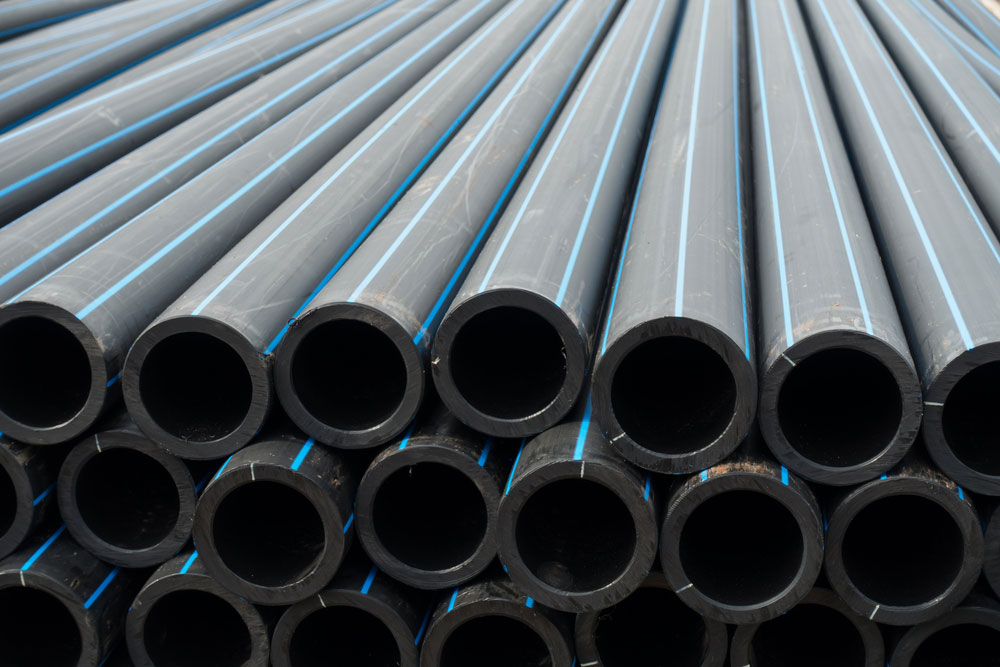Where to Find hdpe pipe in stock Midland TX for Immediate Delivery
Check Out the Production Refine Behind High-Quality HDPE Pipeline and Its Applications
The manufacturing procedure of top quality HDPE pipes is complex and systematic. It begins with the choice of raw materials that improve performance. Following this, ethylene goes through polymerization to develop material, which is after that shaped through extrusion. Quality assurance is critical, guaranteeing that the final product meets rigorous standards. Nonetheless, the trip of HDPE pipelines does not finish with manufacturing. Their applications across numerous sectors expose a wider significance worth checking out.
Comprehending HDPE: Qualities and Advantages

High-density polyethylene (HDPE) is a flexible polycarbonate understood for its longevity and resistance to different ecological variables. This material exhibits superb tensile stamina, making it ideal for demanding applications. Its low-density structure contributes to a light-weight item, assisting in simplicity of dealing with and installation. HDPE additionally showcases impressive resistance to chemicals, which decreases deterioration when revealed to severe compounds.
The product's low moisture absorption even more improves its long life, making it perfect for use in pipes and tank. In addition, HDPE is resistant to ultraviolet (UV) radiation, guaranteeing that items preserve their honesty even when subjected to sunlight. Its adaptability allows for the creation of elaborate forms without compromising toughness. The eco-friendly nature of HDPE, typically originated from recycled products, includes in its appeal, advertising lasting practices in manufacturing. Generally, these properties and advantages make HDPE a favored option for various industrial and customer applications.
Raw Product Selection for HDPE Production
The option of basic materials for HDPE manufacturing is vital to confirm the end product fulfills the wanted specifications and quality standards. High-density polyethylene (HDPE) is mostly created from polymerized ethylene, derived from fossil fuels such as all-natural gas or crude oil. The high quality of these feedstocks greatly affects the mechanical and thermal properties of the last HDPE.
Additives additionally play a considerable role in improving HDPE's performance, consisting of antioxidants, UV stabilizers, and colorants, which boost durability and resistance to ecological aspects. The selection procedure need to think about not just the chemical make-up of the raw products yet likewise their processing qualities to guarantee effective manufacturing.
In addition, the sourcing of resources ought to prioritize sustainability and conformity with environmental regulations, as accountable practices are necessary in today's market. Ultimately, cautious raw material option lays the structure for producing high-quality HDPE pipes appropriate for varied applications.
The Extrusion Process: Shaping HDPE Pipe
The extrusion process plays an essential role in forming HDPE pipelines, beginning with precise product preparation methods that ensure ideal flow and consistency. Just as important is the style of the die, which straight affects the last measurements and surface high quality of the pipe. Together, these aspects add considerably to the performance and high quality of HDPE pipeline production.
Material Preparation Methods
Effective manufacturing of HDPE pipelines starts with meticulous product preparation techniques, particularly the extrusion process. Throughout this stage, high-density polyethylene resin is very first dried out to remove wetness, making certain ideal flow features. The resin is then fed into the extruder, where it undertakes home heating and melting, changing right into a thick state. This home heating process is thoroughly managed to preserve the product's honesty and efficiency. The liquified HDPE is required via a die, forming it right into a constant pipe form. Appropriate temperature management throughout extrusion is necessary, as it directly impacts the material's residential properties and the last item top quality. As soon as formed, the HDPE pipe is cooled and cut to defined sizes, prepared for succeeding processing and applications.
Die Design Importance
Accuracy in die style plays an essential role in the extrusion procedure of HDPE pipes. The die acts as the last shaping device, straight influencing the pipe's measurements, wall density, and surface area finish. A properly designed die guarantees uniform product flow, lowering flaws such as abnormalities and weak areas. The geometry of the die should be enhanced to fit the details buildings of HDPE, including its viscosity and thermal actions during extrusion. In addition, the cooling price of the material as it passes through the die can substantially affect the pipe's architectural integrity. Consequently, spending in advanced die innovation is vital for manufacturers intending to produce top notch HDPE pipes that fulfill market standards and client assumptions.
Quality Control Steps in HDPE Production
Although different factors influence the high quality of HDPE pipe manufacturing, efficient quality assurance measures are important to assure uniformity and dependability in the final item. Secret high quality control methods include extensive product examination, verifying that the raw polyethylene satisfies established requirements for purity and density. Throughout the extrusion procedure, parameters such as temperature, stress, and cooling time are very closely checked to preserve dimensional accuracy and structural honesty
Additionally, post-production screening is necessary; suppliers commonly conduct hydrostatic examinations to evaluate the pipe's strength and resistance to stress. Visual inspections for surface area flaws even more boost quality guarantee. Accreditation from appropriate criteria organizations, like ASTM or ISO, provides an extra layer of trustworthiness. By applying these comprehensive quality assurance procedures, producers can decrease flaws, boost performance, and make sure that the HDPE pipes satisfy the click here specific demands of numerous applications, eventually leading to client complete satisfaction and count on the item.
Applications of HDPE Pipe Across Industries
HDPE pipelines are made use of throughout various markets as a result of their longevity and flexibility. In water distribution systems, they assure effective distribution, while in wastewater management, they supply dependable services for waste transportation. In addition, agricultural watering networks take advantage of HDPE's resistance to corrosion and flexibility, making it a suitable option for modern-day farming techniques.

Water Circulation Systems
A considerable number of sectors count on high-density polyethylene (HDPE) pipelines for efficient water distribution systems. Understood for their resilience and resistance to rust, HDPE pipelines are extensively made use of in community water supply networks, agricultural irrigation, and industrial applications. Their lightweight nature promotes easy handling and installation, decreasing labor expenses and time. Additionally, HDPE pipes can suit different pressure degrees, making them appropriate for both low and high-pressure systems. Pipe Supplier American Plastics Midland. The adaptability of the product enables smooth combination right into existing framework, decreasing the demand for extensive excavation. Moreover, HDPE's resistance to chemical leaching assurances that the water delivered remains safe and tidy, making it an optimal option for maintaining the quality of potable water throughout numerous markets
Wastewater Monitoring Solutions
Reliable water circulation systems additionally lead the way for cutting-edge wastewater monitoring options, where high-density polyethylene (HDPE) pipes play a considerable function. Distinguished for their toughness and resistance to corrosion, HDPE pipes are suitable for moving wastewater in various settings. Their versatility enables very easy installment in intricate environments, reducing the requirement for considerable excavation. In addition, HDPE's smooth indoor surface minimizes rubbing, boosting circulation prices and efficiency. These pipes are also resistant to chemical leaching, guaranteeing that impurities do not endanger the surrounding setting. Industries, districts, and therapy facilities significantly depend on HDPE pipelines for their dependability and long life, making them a favored option for contemporary wastewater administration systems. This adaptability underscores the vital relevance of HDPE pipes across numerous applications.
Agricultural Watering Networks
Agricultural watering networks profit significantly from making use of high-density polyethylene (HDPE) pipelines, which provide effective and reliable water shipment to plants. HDPE pipes are lightweight, making them very easy to move and set up, while their versatility allows for numerous setups in diverse surfaces. These pipes demonstrate excellent resistance to deterioration, chemicals, and UV radiation, making certain resilience in extreme agricultural settings. Furthermore, their smooth interior surface area lessens friction loss, maximizing water flow and reducing power expenses related to pumping. The durability of HDPE pipelines, usually going beyond half a century, contributes to decrease maintenance and substitute costs. Farmers significantly rely on HDPE pipes to improve watering efficiency and promote sustainable farming techniques, ultimately leading to boosted plant returns and resource preservation.

Future Fads in HDPE Pipe Modern Technology
As the demand for lasting and efficient facilities expands, developments in HDPE pipe innovation are positioned to transform different industries. Emerging patterns consist of the assimilation of smart modern technologies, such as sensors and IoT capabilities, which assist in real-time monitoring of pipe problems, decreasing upkeep prices and avoiding leaks. In addition, the advancement of advanced production methods, such as 3D printing, is allowing the manufacturing of complex, customized pipe styles that deal with particular job needs.
Furthermore, the concentrate on recycling and round economy practices is driving the technology of HDPE pipelines made from recycled materials, boosting sustainability. Improved jointing approaches, such as electro-fusion and mechanical installations, are additionally enhancing setup efficiency and reliability. Finally, the expanding emphasis on ecological laws is pushing producers to take on greener manufacturing processes, ensuring that HDPE pipes not only meet sector requirements but likewise foster an even more lasting future for facilities advancement.
Frequently Asked Questions
How Does HDPE Contrast to Various Other Plastic Materials?
HDPE exceeds many various other plastic materials concerning durability, chemical resistance, and versatility. Its low thickness and high tensile stamina make it ideal for numerous applications, commonly going beyond options in both efficiency and long life.
What Are the Ecological Influences of HDPE Manufacturing?
The ecological effects of HDPE manufacturing include greenhouse gas exhausts, power intake, and possible air pollution from manufacturing processes. Additionally, improper disposal can cause soil and water contamination, increasing problems concerning long-term environmental effects.
Can HDPE Pipes Be Recycled?
Yes, HDPE pipelines can be reused. Many centers approve utilized HDPE for handling, changing it into new items. This recycling adds to sustainability efforts, decreasing plastic waste while saving sources and power in the production cycle.
What Is the Life Expectancy of HDPE Pipes?

How Do Temperature Level Variations Influence HDPE Pipe Efficiency?
Temperature variants substantially influence HDPE pipeline efficiency, impacting adaptability and toughness. Heats can bring about softening, while low temperature levels may create brittleness, inevitably affecting the pipe's resilience and viability for various applications in diverse settings.